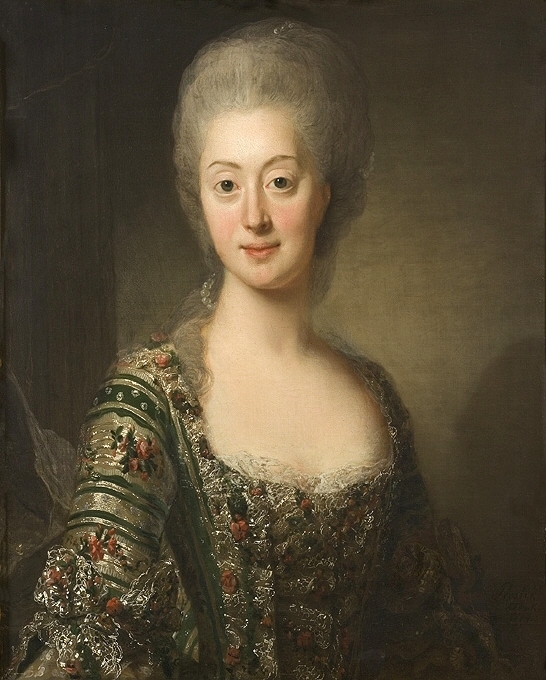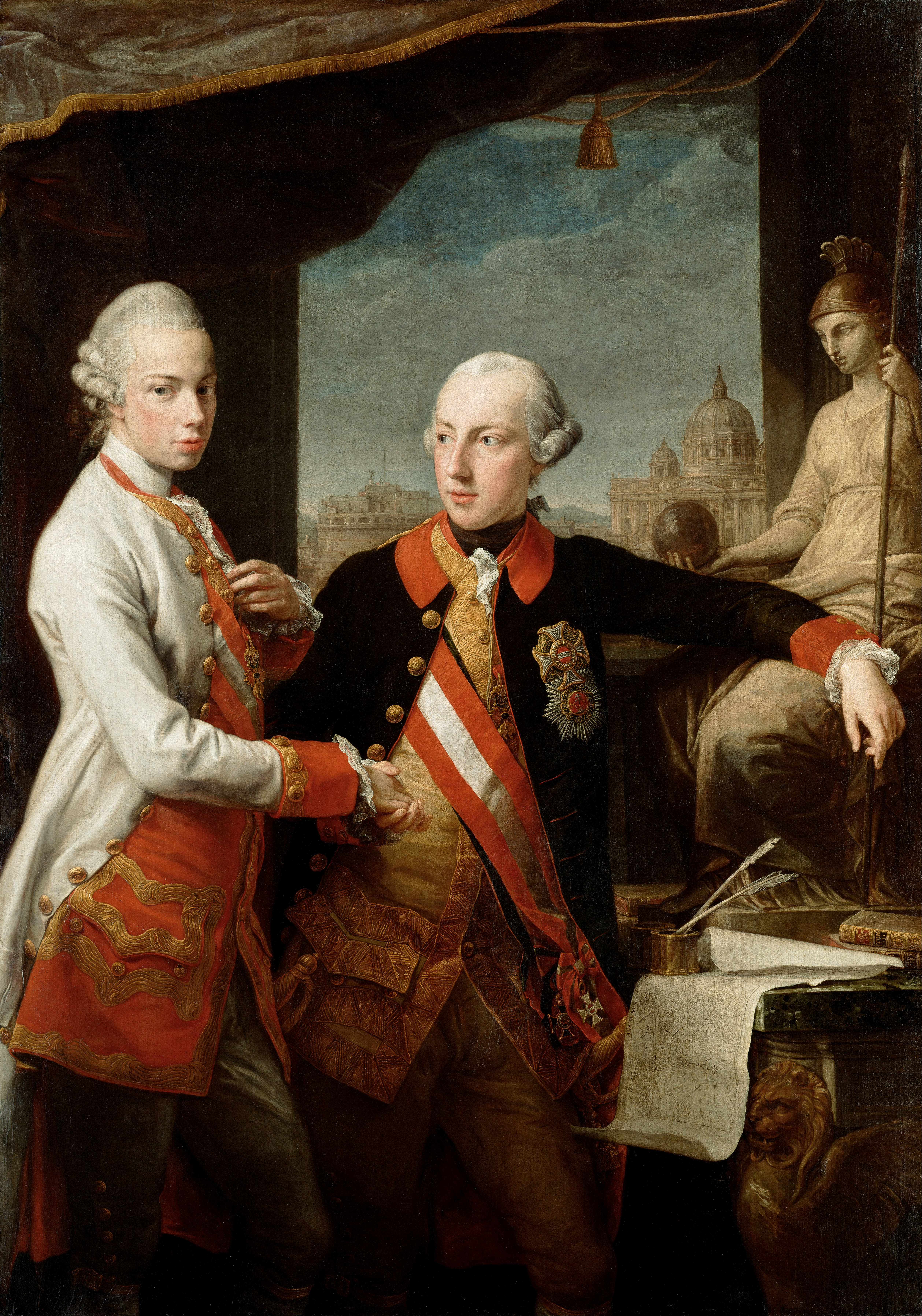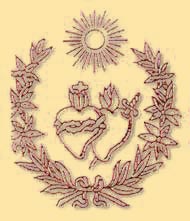|
Demetrius Augustine Gallitzin
Demetrius Augustine Gallitzin (, December 22, 1770 – May 6, 1840) was an emigre Russian aristocrat and Catholic priest known as "The Apostle of the Alleghenies" and also in the United States as Prince Gallitzin. He was a member of the House of Golitsyn. Since 2005, he has been under consideration for canonization by the Catholic Church. His current title is Servant of God, granted by Pope Benedict XVI in 2005. Early life Gallitzin was born into nobility on December 22, 1770 at The Hague. His father, Prince Dimitri Alexeievich, the Russian ambassador to the Netherlands, was an intimate friend of Voltaire and a follower of Diderot. His mother was the Prussian Countess Adelheid Amalie von Schmettau, the daughter of Field Marshall Samuel von Schmettau. When Prince Demitri was about two years old, the Empress Catherine the Great visited The Hague, and as a sign of special favor to his father, cradled the child in her arms and appointed the boy an officer of the guard. He was ... [...More Info...] [...Related Items...] OR: [Wikipedia] [Google] [Baidu] |
Servant Of God
Servant of God () is a title used in the Catholic Church to indicate that an individual is on the first step toward possible canonization as a saint. Terminology The expression ''Servant of God'' appears nine times in the Bible, the first five in the Old Testament, the last four in the New Testament, New. The Hebrew Bible refers to Moses as "the servant of Elohim" (עֶֽבֶד הָאֱלֹהִ֛ים ''‘eḇeḏ-hā’ĕlōhîm''; , , , and ). and refer to Joshua as "the slave of Yahweh" (עֶ֣בֶד יְהוָ֑ה, ''‘eḇeḏ Yahweh''). The New Testament also describes Moses in this way in (τοῦ δούλου τοῦ Θεοῦ, ''tou doulou tou Theou''). Paul the Apostle, Paul calls himself "a servant of God" in (δοῦλος Θεοῦ, ''doulos Theou''), while Epistle of James, James calls himself "a servant of God and the Lord Jesus Christ" (θεοῦ καὶ κυρίου Ἰησοῦ χριστοῦ δοῦλος, ''Theou kai Kyriou Iēsou Christou doulos'') in . ... [...More Info...] [...Related Items...] OR: [Wikipedia] [Google] [Baidu] |
Catherine The Great
Catherine II. (born Princess Sophie of Anhalt-Zerbst; 2 May 172917 November 1796), most commonly known as Catherine the Great, was the reigning empress of Russia from 1762 to 1796. She came to power after overthrowing her husband, Peter III. Under her long reign, inspired by the ideas of the Enlightenment, Russia experienced a renaissance of culture and sciences, which led to the founding of many new cities, universities, and theatres, along with large-scale immigration from the rest of Europe and the recognition of Russia as one of the great powers of Europe. In her accession to power and her rule of the empire, Catherine often relied on her noble favourites, most notably Count Grigory Orlov and Grigory Potemkin. Assisted by highly successful generals such as Alexander Suvorov and Pyotr Rumyantsev, and admirals such as Samuel Greig and Fyodor Ushakov, she governed at a time when the Russian Empire was expanding rapidly by conquest and diplomacy. In the south, the ... [...More Info...] [...Related Items...] OR: [Wikipedia] [Google] [Baidu] |
John Carroll (priest)
John Carroll (January 8, 1735 – December 3, 1815) was an American Catholic prelate who served as the first Bishop of Baltimore, then the only diocese in the nascent United States, from 1789 to 1815. He became the first Archbishop of Baltimore in 1808, up to which point Carroll had also administered the entire U.S. Catholic Church. Born to an aristocratic family in the colonial-era Province of Maryland, Carroll spent most of his early years as a priest in Europe, teaching and serving as a chaplain. After returning to Maryland in 1773, he started organizing the Catholic Church in America with a small cadre of priests. The Vatican appointed him to several roles as leader of the American Catholic hierarchy, culminating in his appointment as archbishop. Carroll founded Georgetown University in Washington, D.C., and St. John the Evangelist Parish in Silver Spring, Maryland, the first secular parish in the country. Early life and education Carroll was born on January 8, 1 ... [...More Info...] [...Related Items...] OR: [Wikipedia] [Google] [Baidu] |
Gustav III Of Sweden
Gustav III (29 March 1792), also called ''Gustavus III'', was King of Sweden from 1771 until his assassination in 1792. He was the eldest son of King Adolf Frederick and Queen Louisa Ulrika of Sweden. Gustav was a vocal opponent of what he saw as the abuse of political privileges seized by the nobility since the death of King Charles XII in the Great Northern War. Seizing power from the government in a coup d'état, called the Swedish Revolution, in 1772, that ended the Age of Liberty, he initiated a campaign to restore a measure of royal autocracy. This was completed by the Union and Security Act of 1789, which swept away most of the powers exercised by the Swedish Riksdag of the estates during the Age of Liberty, but at the same time it opened up the government for all citizens, thereby breaking the privileges of the nobility. A believer in enlightened absolutism, Gustav spent considerable public funds on cultural ventures, which were controversial among his critics, as ... [...More Info...] [...Related Items...] OR: [Wikipedia] [Google] [Baidu] |
Leopold II, Holy Roman Emperor
Leopold II (Peter Leopold Josef Anton Joachim Pius Gotthard; 5 May 1747 – 1 March 1792) was the penultimate Holy Roman Emperor, as well as King of Hungary, Croatia and King of Bohemia, Bohemia, and List of rulers of Austria, Archduke of Austria from 1790 to 1792, and List of rulers of Tuscany, Grand Duke of Tuscany from 1765 to 1790. He was a son of Empress Maria Theresa and Emperor Francis I, Holy Roman Emperor, Francis I, and the brother of Queen Marie Antoinette of France, Queen Maria Carolina of Austria, Maria Carolina, Duchess Maria Amalia of Parma, and Emperor Joseph II. Leopold was a moderate proponent of enlightened absolutism like his brother Joseph II, Holy Roman Emperor, Joseph II. He granted the Accademia_dei_Georgofili, Academy of Georgofili his protection. Unusually for his time, he opposed the death penalty and torture and abolished it in Grand Duchy of Tuscany, Tuscany on 30 November 1786 during his rule there, making it the first nation in modern history to do s ... [...More Info...] [...Related Items...] OR: [Wikipedia] [Google] [Baidu] |
Duchy Of Brabant
The Duchy of Brabant, a Imperial State, state of the Holy Roman Empire, was established in 1183. It developed from the Landgraviate of Brabant of 1085–1183, and formed the heart of the historic Low Countries. The Duchy comprised part of the Burgundian Netherlands from 1430 and of the Habsburg Netherlands from 1482, until it was partitioned after the Dutch revolt of 1566–1648. The 1648 Peace of Westphalia ceded present-day North Brabant () to the Generality Lands of the Dutch Republic, while the reduced duchy remained part of the Habsburg Netherlands until French First Republic , French Revolutionary forces conquered it in 1794 — a change recognized by the Treaty of Campo Formio in 1797. Today all the duchy's former territories, apart from exclaves, are in Belgium except for the Dutch province of North Brabant. Geography The Duchy of Brabant (adjective: ''wikt:Brabantian, Brabantian'' or ''wikt:Brabantine, Brabantine'') was historically divided into four parts, each with ... [...More Info...] [...Related Items...] OR: [Wikipedia] [Google] [Baidu] |
Austrian Empire
The Austrian Empire, officially known as the Empire of Austria, was a Multinational state, multinational European Great Powers, great power from 1804 to 1867, created by proclamation out of the Habsburg monarchy, realms of the Habsburgs. During its existence, it was the third most populous monarchy in Europe after the Russian Empire and the United Kingdom of Great Britain and Ireland, United Kingdom, while geographically, it was the third-largest empire in Europe after the Russian Empire and the First French Empire. The empire was proclaimed by Francis II, Holy Roman Emperor, Francis II in 1804 in response to Napoleon's declaration of the First French Empire, unifying all Habsburg monarchy, Habsburg possessions under one central government. It remained part of the Holy Roman Empire until the latter's dissolution in 1806. It continued fighting against Napoleon throughout the Napoleonic Wars, except for a period between 1809 and 1813, when Austria was first allied with Napoleon ... [...More Info...] [...Related Items...] OR: [Wikipedia] [Google] [Baidu] |
Saint Petersburg
Saint Petersburg, formerly known as Petrograd and later Leningrad, is the List of cities and towns in Russia by population, second-largest city in Russia after Moscow. It is situated on the Neva, River Neva, at the head of the Gulf of Finland on the Baltic Sea. The city had a population of 5,601,911 residents as of 2021, with more than 6.4 million people living in the Saint Petersburg metropolitan area, metropolitan area. Saint Petersburg is the List of European cities by population within city limits, fourth-most populous city in Europe, the List of cities and towns around the Baltic Sea, most populous city on the Baltic Sea, and the world's List of northernmost items#Cities and settlements, northernmost city of more than 1 million residents. As the former capital of the Russian Empire, and a Ports of the Baltic Sea, historically strategic port, it is governed as a Federal cities of Russia, federal city. The city was founded by Tsar Peter the Great on 27 May 1703 on the s ... [...More Info...] [...Related Items...] OR: [Wikipedia] [Google] [Baidu] |
Society Of The Sacred Heart
The Society of the Sacred Heart of Jesus (; ), abbreviated RSCJ, is a Catholic centralized religious institute of consecrated life of pontifical right for women established in France by Madeleine Sophie Barat in 1800. History Madeleine Sophie Barat founded the Society of the Sacred Heart of Jesus in the wake of the French Revolution to provide educational opportunities for girls. The manner of life was to be simple without the prescribed austerities of the older orders, which would be incompatible with the work of education. In some houses the religious conducted just one school, but in several places, especially in the larger houses in cities there were at least two schools, a boarding school and a school for poor children. The first convent was opened at Amiens in 1801. In 1820 the French Government gave a run down property now known as Hotel Biron (current Rodin Museum) to the Society. Other houses were opened in Grenoble, Niort, Poitiers and Cuigniers. In 1826 the socie ... [...More Info...] [...Related Items...] OR: [Wikipedia] [Google] [Baidu] |
Yelizaveta Golitsyna
Sister Yelizaveta Alexeyevna Golitsyna (also Elizabeth Gallitzin) (22 February 1797 in Saint Petersburg, Russian Empire – 26 November 1844 in Louisiana, United States of America) was a Russian noble and Catholic nun, who converted from Russian Orthodoxy. Biography Yelizaveta Golitsyna was born 22 February 1797 in Saint Petersburg, Russia to the family of Prince Alexei Andreevich Golitsyn and Princess Alexandra Golitsyna. She was baptized and brought up in the Russian Orthodox Church. When she was 15, she learned that her mother and her aunt converted to Catholicism (the aunt, a revert to the faith, was the mother of future Catholic priest Demetrius Gallitzin). Outraged by this "betrayal," Golitsyna vowed never to change her religion, but over the next four years, her rejection of Catholicism was replaced by interest and desire to know more. Eventually, Yelizaveta also joined the Catholic Church. During one of her trips abroad, Golitsyna met Jesuit Father Rozaven, whom she ... [...More Info...] [...Related Items...] OR: [Wikipedia] [Google] [Baidu] |
Augustine Of Hippo
Augustine of Hippo ( , ; ; 13 November 354 – 28 August 430) was a theologian and philosopher of Berber origin and the bishop of Hippo Regius in Numidia, Roman North Africa. His writings deeply influenced the development of Western philosophy and Western Christianity, and he is viewed as one of the most important Church Fathers of the Latin Church in the Patristic Period. His many important works include '' The City of God'', '' On Christian Doctrine'', and '' Confessions''. According to his contemporary, Jerome of Stridon, Augustine "established anew the ancient Faith". In his youth he was drawn to the Manichaean faith, and later to the Hellenistic philosophy of Neoplatonism. After his conversion to Christianity and baptism in 386, Augustine developed his own approach to philosophy and theology, accommodating a variety of methods and perspectives. Believing the grace of Christ was indispensable to human freedom, he helped formulate the doctrine of original sin and m ... [...More Info...] [...Related Items...] OR: [Wikipedia] [Google] [Baidu] |






